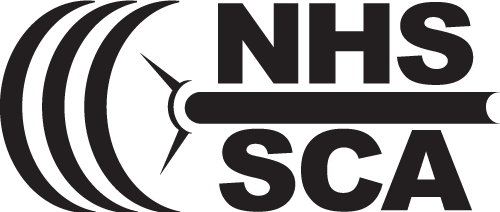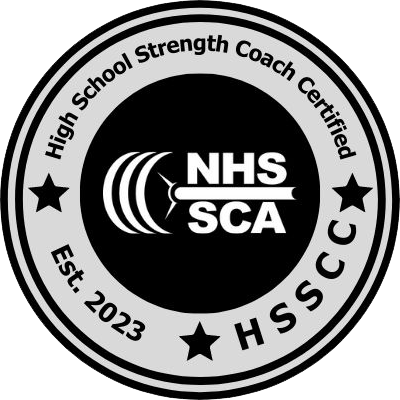The Challenge of Training High School Athletes
“Developing young athletes should not copy what local D1 athletes are doing in their programs. They are older, more mature, and most are a different level of athlete entirely.”
This was a statement I had heard many times—and completely agreed with. Yet, like many others, I initially modeled my early programs on my experience as a track and field thrower at Iowa State University and my work as a Graduate Assistant at Illinois State University. It was all I knew. While my approach wasn’t wrong, I realized it wasn’t optimized for high school athletes, and I wanted to find a better way to serve them with developmentally appropriate training.
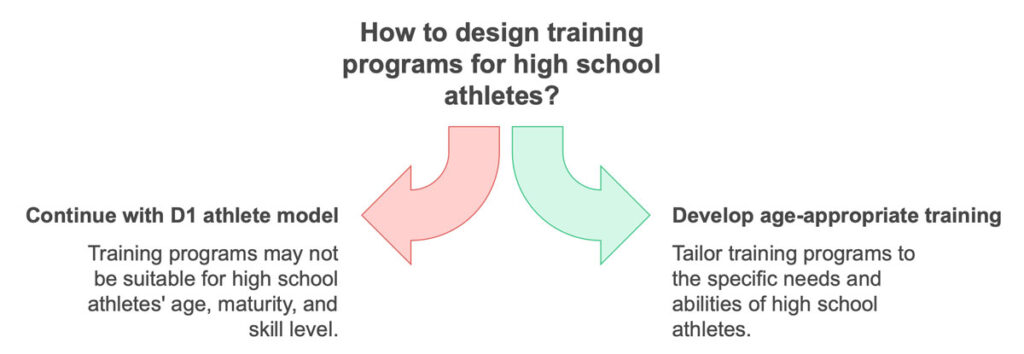
Discovering a Simpler Approach
At Jay DeMayo’s Central Virginia Sport Performance Seminar, I was introduced to the idea of doing only what is necessary for performance. This philosophy—focusing on effective simplicity—made me rethink my reliance on high-volume sets. High-intensity programs have a place in long-term training, but they didn’t fit the developmental needs of young athletes juggling school, sports, and life.
Dr. Yessis’ insight that many high school athletes exist in a state of sub-maximal fatigue further validated my shift toward a lighter, more sustainable model. The simplicity of doing one set of each exercise daily made sense for our program’s goals.
Why the 1×20 Program Fits Our Athletes
The 1×20 program introduces training concepts progressively, making it an ideal entry point for novice athletes with a training age of zero. It builds on the cumulative effect of training, where small, consistent efforts compound into long-term success. The simplicity and low intensity allow athletes to focus on learning movement patterns without being overwhelmed.
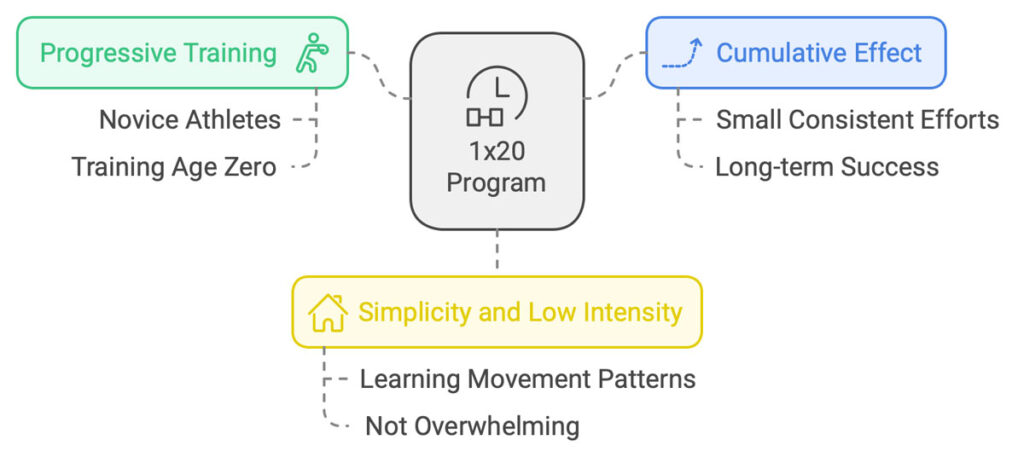
Early-Stage Training: Teaching Movement Patterns
We start our 8th and 9th graders with an eight-week block focused on movement patterns. This introductory phase is light on volume and emphasizes basic exercises—calisthenics, jumps, crawls, and simple movements like unilateral squats and hip hinges. Upperclassmen assist by leading stations as peer coaches, fostering leadership and reinforcing fundamentals.
Early-Stage 1×20 Program: Teaching Movement Patterns (8-Week Block)
Here’s a workout template aligned with the 1×20 Program principles for early-stage training to teach 8th and 9th graders movement patterns. This plan incorporates basic movements, leadership development, and gradual progressions, with upperclassmen acting as peer coaches.
Day 1: Full-Body Movement Fundamentals
| Exercise | Sets & Reps | Notes |
|---|---|---|
| Bodyweight Squat | 1 x 20 | Focus on form; peer coach provides feedback. |
| Push-Ups | 1 x 20 | Modify as needed (knees or incline). |
| Glute Bridge | 1 x 20 | Emphasize hip extension and engagement. |
| Bird-Dog (10 per side) | 1 x 20 | Develop core stability and control. |
| Unilateral Step-Up (10 per leg) | 1 x 20 | Progress to dumbbells if form allows. |
Day 2: Introduction to Hip Hinges & Crawling Movements
| Exercise | Sets & Reps | Notes |
|---|---|---|
| Push Plate Squat | 1 x 20 | Use a light plate for depth cueing. |
| Hip Hinge with Dowel | 1 x 20 | Ensure back remains flat throughout the movement. |
| Bear Crawl (10 yards) | 1 x 20 | Peer coach assists with form. |
| Dead Bug (10 per side) | 1 x 20 | Focus on slow, controlled movement. |
| Lunges (10 per leg) | 1 x 20 | Progress to walking lunges over time. |
Day 3: Rotational & Jumping Movements
| Exercise | Sets & Reps | Notes |
|---|---|---|
| Medicine Ball Scoop Toss (10 per side) | 1 x 20 | Focus on rotational power development. |
| Broad Jumps | 1 x 20 | Controlled landing; progress to consecutive jumps. |
| Plank Hold (20 sec) | 1 x 20 | Peer coach cues proper posture. |
| Step-Back Lunges (10 per side) | 1 x 20 | Progress to weighted lunges if appropriate. |
| Wall Sit Hold (20 sec) | 1 x 20 | Peer coach monitors form and engagement. |
Progression Guidelines
- Exercise Volume: Start with 6–12 exercises per session and gradually increase to 20 over several weeks.
- Repetition Frequency: Perform the same exercises two to three times per week for motor learning.
- Technical Focus: Prioritize technical failure—end a set if form breaks down to avoid injury.
- Progression: Gradually increase resistance or reps, but never at the expense of form or speed.
- Peer Coaching: Encourage advanced athletes to assist in leading stations, reinforcing leadership skills and technique.
This workout template blends 1×20 system principles with High School Strength Coach Certified (HSSCC) methodologies. It ensures gradual progression, motor learning, quality movement patterns, and leadership development. Coaches with HSSCC certification gain access to advanced programming, helping athletes excel in power, speed, and strength while emphasizing proper technique and injury prevention.
Progressing the 1×20 System
After the initial phase, we introduce a progression of 6–12 exercises, working toward 20 exercises per session. These exercises cover both compound and single-joint movements, such as hip adduction/abduction. We focus on motor learning by repeating the same exercises two to three times per week, gradually increasing reps and weights.
The progression emphasizes technical failure—the point where form breaks down—not absolute failure. Athletes learn the importance of quality over quantity, understanding that how they lift matters as much as what they lift.
1×20 System Progression Template
Focus: Gradually increasing exercise volume (6–12 exercises progressing to 20), emphasizing technical failure rather than absolute failure.
Day 1: Lower Body Focus
| Exercise | Sets x Reps | Notes |
|---|---|---|
| Goblet Squat | 1 x 20 | Focus on depth and controlled descent. |
| Romanian Deadlift (RDL) | 1 x 20 | Emphasize hamstring engagement. |
| Step-Ups (Bodyweight or Dumbbells) | 1 x 20 per leg | Controlled movement through entire range. |
| Hip Adduction Machine | 1 x 20 | Light weight to maintain form throughout. |
| Plank Hold | 3 x 30 seconds | Maintain neutral spine and control breathing. |
| Jump Rope (Conditioning) | 3 x 1 minute | Focus on rhythm and coordination. |
Day 2: Upper Body Focus
| Exercise | Sets x Reps | Notes |
|---|---|---|
| Push-Ups | 1 x 20 | Maintain a tight core and neutral alignment. |
| Dumbbell Bench Press | 1 x 20 | Slow, controlled presses; avoid locking out elbows. |
| Dumbbell Row | 1 x 20 per arm | Keep shoulder blades retracted throughout. |
| Lateral Raises | 1 x 20 | Light weight to avoid shoulder strain. |
| Hip Abduction Machine | 1 x 20 | Ensure smooth, controlled movement. |
| Medicine Ball Slams | 3 x 10 | Explosive movement while maintaining form. |
Day 3: Total Body Focus
| Exercise | Sets x Reps | Notes |
|---|---|---|
| Front Squat (Light Weight) | 1 x 20 | Focus on upright posture and smooth descent. |
| Dumbbell Deadlift | 1 x 20 | Control on lowering phase, avoiding jerky motions. |
| Seated Shoulder Press | 1 x 20 | Keep core tight and avoid leaning back. |
| Dumbbell Bicep Curl | 1 x 20 | Smooth tempo; avoid swinging the weight. |
| Russian Twists | 3 x 15 per side | Maintain controlled rotation. |
| Farmer’s Carry (30 yards) | 3 sets | Emphasize posture and grip strength. |
Progression Guidelines:
- Bodyweight Squats: Begin with 1 set of 20 reps. Progress to goblet squats with a dumbbell when the athlete demonstrates proper depth and form.
- Push-Ups: Start with modified push-ups if necessary. Once the athlete completes 20 reps with good form, progress to standard push-ups or add a weighted vest.
- Hip Adduction/Abduction Movements: Introduce resistance bands after the initial phase. Progress to cable machine exercises for more resistance as needed.
- Overhead Press: Begin with light dumbbells or resistance bands. Transition to barbell overhead presses after the athlete shows technical competence.
- Lunges: Start with bodyweight walking lunges. Progress to dumbbell lunges as strength improves, focusing on maintaining balance and alignment.
- Pull-Ups/Assisted Pull-Ups: Use a band for assistance. Gradually reduce band resistance until the athlete can complete 20 unassisted pull-ups.
- Deadlifts: Begin with kettlebell deadlifts. Progress to trap bar deadlifts, then to conventional deadlifts as the athlete’s strength and form improve.
Each phase focuses on motor learning by repeating the same exercises two to three times per week, gradually increasing reps or resistance. Athletes are taught to prioritize technical failure—the point where form deteriorates—over absolute failure, reinforcing the importance of quality movement over simply completing repetitions.
This workout template integrates the foundational principles of the 1×20 system with advanced methodologies from the High School Strength Coach Certified (HSSCC) program. It promotes steady progression, motor learning, proper movement patterns, and leadership skills. HSSCC-certified coaches benefit from cutting-edge programming, equipping athletes to thrive in power, speed, and strength while prioritizing technique and reducing the risk of injury.
Managing Load and Intensity
Our approach to progression is deliberate. We start with lighter weights and gradually increase the load until athletes can no longer complete 20 reps with good form. This slow, steady adaptation helps avoid overloading the nervous system and reduces the risk of injury. We encourage athletes to train hard, challenging them to push their limits without compromising technique.

Adapting Training Across Seasons
Our program adapts to the needs of athletes with busy schedules. In-season, we adjust volume and intensity to match their sport demands, alternating between higher-rep blocks and speed-focused phases. This flexible approach ensures athletes continue developing throughout the year without burnout.
For advanced athletes, we occasionally integrate specialized exercises targeting sprinting mechanics, cutting actions, and rotational movements. This targeted work ensures they develop sport-specific skills while maintaining overall strength.
Adapting Training Across Seasons
Our program adapts to the needs of athletes with busy schedules. In-season, we adjust volume and intensity to match their sport demands, alternating between higher-rep blocks and speed-focused phases. This flexible approach ensures athletes continue developing throughout the year without burnout.
For advanced athletes, we occasionally integrate specialized exercises targeting sprinting mechanics, cutting actions, and rotational movements. This targeted work ensures they develop sport-specific skills while maintaining overall strength.
| Season | Focus | Example Exercises |
|---|---|---|
| Pre-Season | Higher reps, building endurance and strength | Goblet Squats, Push-Ups, Medicine Ball Slams |
| In-Season | Lower volume, maintaining strength and speed | Trap Bar Deadlift, Box Jumps, Dumbbell Bench Press |
| Post-Season | Recovery, mobility, and injury prevention | Foam Rolling, Band Pull-Aparts, Tempo Lunges |
| Advanced Athletes | Sport-specific work and mechanics | Sled Push, Rotational Throws, Sprint Drills |
Pre-Season Workout Template
| Exercise | Sets | Reps | Focus |
|---|---|---|---|
| Back Squat | 4 | 8 | Build endurance and strength |
| Dumbbell Bench Press | 4 | 8 | Hypertrophy and upper body strength |
| Romanian Deadlift (RDL) | 3 | 10 | Posterior chain development |
| Box Jumps | 3 | 8 | Explosiveness |
| Plank Hold | 3 | 60 sec | Core stability |
In-Season Workout Template
| Exercise | Sets | Reps | Focus |
|---|---|---|---|
| Trap Bar Deadlift | 3 | 5 | Maintain strength |
| Dumbbell Push Press | 3 | 6 | Maintain upper body power |
| Lunges | 3 | 8 per leg | Single-leg strength |
| Box Jumps | 3 | 6 | Speed and explosiveness |
| Banded Pull-Aparts | 3 | 15 | Shoulder stability |
Post-Season Workout Template
| Exercise | Sets | Reps | Focus |
|---|---|---|---|
| Goblet Squat | 3 | 10 | Mobility and recovery |
| Dumbbell Bench Press | 3 | 8 | Maintain upper body strength |
| Tempo Lunges | 3 | 8 per leg | Controlled movement |
| Foam Rolling | — | 5-10 min | Recovery |
| Plank Variations | 3 | 30-60 sec | Core stability |
This workout template combines the core principles of the 1×20 system with the advanced strategies taught in the High School Strength Coach Certified (HSSCC) program. It emphasizes gradual progression, motor learning, efficient movement patterns, and leadership development. Through HSSCC certification, coaches gain access to innovative programming that prepares athletes to excel in power, speed, and strength, all while maintaining proper technique and minimizing injury risks.
The Value of Specialized Exercises
While general strength training builds a solid foundation, specialized exercises—when used strategically—enhance performance in specific sports. These exercises only constitute a small percentage of training but, when executed with intent and precision, can significantly improve athletic skills.
Long-Term Benefits of the 1×20 Program
The 1×20 program offers several key benefits:
- Consistency and Frequency: Regular practice improves motor skills and movement efficiency.
- Lower Fatigue: Reduced intensity minimizes nervous system stress and aids recovery.
- Injury Prevention: Strengthening connective tissues and improving aerobic capacity lowers injury risk.
These benefits have contributed to the success of our athletes and our program. A local physical therapist recently praised North Scott’s strength and conditioning program as the “gold standard” for its low injury rates. While we know that no single program guarantees injury prevention, we take pride in contributing to the health and safety of our athletes.
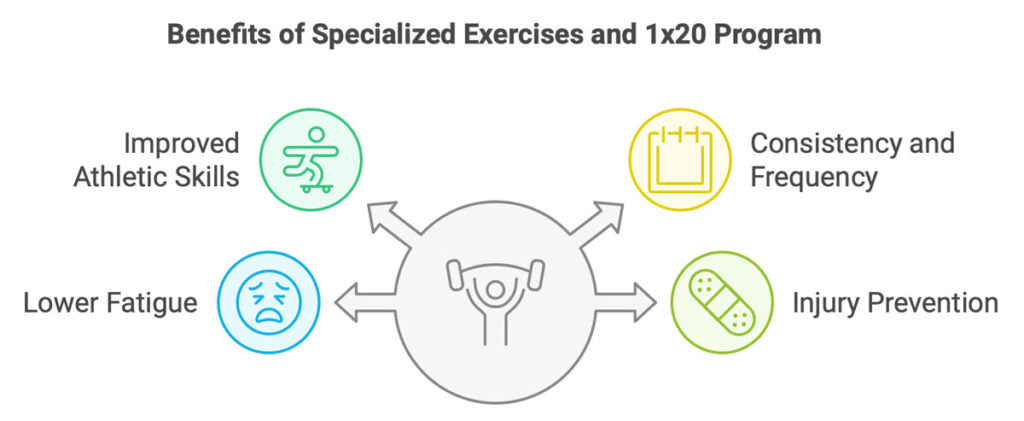
Final Thoughts: Adapting the Program to Individual Athletes
Each athlete progresses at their own pace. Some may reach advanced methods like the shock method, while others focus on foundational skills throughout high school. The goal is to provide the right dose of training at the right time, ensuring every athlete develops to their fullest potential.
About the Author
Tony Stewart, M.S., CSCS, is in his 15th year as the Head Strength & Conditioning Coach at North Scott High School in Iowa. He holds a bachelor’s degree from Iowa State University, where he competed in track and field, and a master’s degree in Kinesiology from Illinois State University. In 2022, he was named the NHSSCA Mid-America Regional Coach of the Year and currently serves on the NHSSCA Regional Board.
